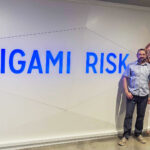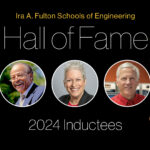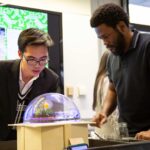
Electrical engineering capstone innovation
Graduating seniors displayed their ingenuity at Spring 2023 electrical engineering Senior Design Capstone Demo Day

One of the final tasks for graduating electrical engineering seniors in the Ira A. Fulton Schools of Engineering at Arizona State University is to solve a real-world problem using skills learned in their studies. In a test of these abilities, students formulate a group capstone project involving electrical engineering.
For the Spring 2023 semester, dozens of teams from the School of Electrical, Computer and Energy Engineering, part of the Fulton Schools, presented projects to show off the culmination of years of hard work and dedication required to earn degrees.
Forty-nine teams of both online and on-campus students displayed their solutions to electrical engineering problems in a variety of fields, including enhancing solar power generation capabilities, detecting toxic carbon monoxide gas, improving mobility for those with visual disabilities and purifying the air of carbon dioxide.
“We emphasize that a project should be comprehensive and integrate multiple areas covered in their coursework,” says James McDonald, an electrical engineering professor of practice in the Fulton Schools. “The project should also be open-ended and challenging.”
McDonald oversees the capstone project program with electrical engineering Professor of Practice Olin Hartin. McDonald oversees Demo Day events for students graduating in the spring semester, while Hartin takes the same role for fall semester graduates.
Industry members can also sponsor projects by providing funding and mentoring students. Industry mentors this year included representatives from the Salt River Project, Intel, Honeywell and the U.S. Central Intelligence Agency.
Here are some of the students’ innovative and impactful capstone projects.
Reducing carbon dioxide inside buildings
Mentored by a CIA member, a team of on-campus students built a carbon dioxide, or CO2, scrubber that can reduce levels of the gas in the air.
Carbon dioxide can be harmful to humans at high concentrations. At those levels, the gas can cause nausea, headaches and dizziness, and extreme amounts can even be fatal.
While carbon dioxide scrubber technology currently exists, student team member Victoria Lewis explains that those devices have vastly different uses.
“A lot of CO2 scrubbers on the market are industrial ones that tend to be built into buildings or submarines or spacecraft,” Lewis says. “They’re expensive, they have to be built in place and they’re huge.”
Current residential devices on the market are typically low-end models with paper or cardboard filters and don’t display how much carbon dioxide is in the room, Lewis says.
The team’s portable device, powered by a rechargeable battery, brings air into a small plastic box and uses soda lime to remove the gas. The product’s small size is optimal for removing carbon dioxide from the air in a residential setting.
A digital display on the box shows the level of carbon dioxide in the device’s vicinity at any given time. A phone app can also display the level to users at any location.
“This is intended to be a middle of the road model for users that enables them to move it around from room to room,” Lewis says. “They can get the current data of the CO2 rates in the room and know its status and safety level.”

On-campus team members Evelyn Decker and Karen Hartley pose with online team members Lance Hulley, Raymond Mandap and Hudson Reed, who attended through Zoom, with the technology used in their project to dynamically reroute solar panel power generation, adapting to conditions such as shade or damaged solar cells. Photographer: TJ Triolo/ASU
Making solar arrays adaptable for maximum efficiency
A hybrid team of on-campus and online students, mentored by Fulton Schools Associate Professor of electrical engineering Jennifer Kitchen, designed technology to adjust power routing in arrays of solar panels to generate as much power as possible.
Solar panels that are damaged or covered by shade can significantly reduce the amount of power output. This project sought to solve the problem by creating technology that shuts off panels in a solar array that aren’t working optimally.
Team member Hudson Reed says Kitchen used an analogy comparing solar panel arrays to holiday lights: when one bulb goes out, the whole strand doesn’t work. Similarly, when part of a solar array doesn’t work, it causes dramatic drops in output.
Using a combination of programming, microelectronic chips and tiny solar panels, the team created a demonstration with a small fan attached to a mini solar array to show how the program changes which panels are relied on more heavily to generate power on the fly.
Reed uses a theoretical example to show what the technology does: If part of a 20-watt solar array stops working properly because of an issue such as shade, damage or dirt, the output would drop to about 10 watts. Using the team’s optimization technology, the array would then shut off generation from the malfunctioning panel, taking more power in from the panels that are functioning, which would bring the power generation back up to about 18 watts.
This innovation would help extend the lifespan of solar panels for consumers.
“If the panels can change configuration for the most efficient way, then a consumer would most likely keep that product, instead of thinking about replacing it,” Reed says.

The presentation poster for a project by a team of online students who developed a wearable carbon monoxide sensor is displayed at the Spring 2023 Demo Day. Photographer: Erika Gronek/ASU
An economical and portable way to detect carbon monoxide
Another team, consisting entirely of online students, built a wearable carbon monoxide detector for their project. Carbon monoxide is an odorless and toxic gas that can be fatal at much lower levels than carbon dioxide.
While wearable carbon monoxide sensors exist for applications such as safety on industrial worksites, the team sought to differentiate its sensors by making them at a reasonable cost with a variety of types of alerts that signal when sensors detect hazardous amounts of gas via a built-in OLED screen, audio alerts, LED lights and a notification to a phone app. This is a greater variety of alert methods than many other sensors on the market.
The project’s industry mentor was John Lewis, a technology consultant and retired chief technology officer at CIA Labs who helps to guide multiple student capstone project teams each semester.
Lewis and the CIA also provided financial sponsorship that enabled each student to build a sensor device to accommodate their remote locations.
Overcoming visual impairment with vibrations
Each semester, one electrical engineering capstone team is awarded the Palais Senior Design Prize. The winning project is selected by judges on a secret panel selected from among those attending Demo Day who are not presenting their projects. The winning team receives a cash prize and a lunch with Professor Emeritus Joseph Palais, who sponsors the prize with his wife Sandra.
The spring semester’s winner was a team of online students who designed a vest to improve mobility for people with visual impairments. Lewis also mentored this project team with help from a CIA colleague.
The team’s vest uses lidar technology that employs laser light to “see” a sensor’s surroundings. The technology is often used in autonomous vehicles to navigate in surrounding environments.
When the vest’s lidar detects objects, it provides vibrational feedback to the user and alerts them to the obstacle’s location and indicates about how far away the object is. This enables visually impaired people to move around with reduced risks of bumping into obstacles.
“One of our teammates put on a blindfold and was able to navigate an obstacle course using only the feedback from the vest,” says Jonathan Lightner, a member of the winning capstone team.
An industry connection
McDonald sees capstone projects as the perfect opportunity for students to get prepared for working in industry.
“I may be biased because I worked in industry almost my entire career, but I think this course is a perfect introduction to working for a company,” he says. “This is exactly what you will be doing on the job. In this class, you must learn to work together as a team and learn how to manage a project, which includes defining the project scope, the schedule and the budget, just to name a few aspects.”
For the program’s future, McDonald plans to work with his colleague Hartin to incentivize students to form more hybrid teams of on-campus and online students. He says the collaboration with people in various geographic locations and every team having an on-campus presence for Demo Day will benefit students by enabling them to draw on a broader variety of perspectives in efforts to devise engineering solutions.
“Many, if not most, industry projects today consist of team members throughout the U.S. and the world,” McDonald says. “Exposing students to this team environment is another step in preparing them for a job in industry.”
Reflecting on his first Demo Day, McDonald credits the event’s success to assistance from others in the School of Electrical, Computer and Energy Engineering.
“Over the last several weeks of the spring semester, I learned more about putting on the Demo Day event,” McDonald says. “I’m so grateful for all the support from the teaching assistants, information technology and School of Electrical, Computer and Energy Engineering staff. Putting on such an event would not have been possible without their contributions.”


































